Posted: August 5th, 2010 | Author: Nathan | Filed under: field recording, nature recording

Somewhere in the murk there's quite a few noisy critters...
I originally considered this clip an outtake from the Nature Sounds Society Field Workshop this summer (which has been previously covered in older posts). I had never seen white-faced ibises before, and their ducklike honking and loud wing flaps were mixed in with local cows that were just waking up. It was about 7am.
But in listening to it again, I came to love the moment that was captured: Dense fog all around, the sun kissing vernal pools and long-grass marshland in the middle of the Sierra Nevada, and all the animals calling out to each other, re-establishing territory and familial bonds. I came to rather like the sound of the cows mixed in with the ibises, the swallows, and the blackbirds.
Field recordings don’t always have to be pristine to be interesting. Sometimes you must bend your mind to the material.
So, I’ll share it here today. Hang out until the very last bit, where an ibis takes off and flies overhead – great clarity in the call and the wing flaps.
[soundcloud url=”http://soundcloud.com/noisejockey/ibises-and-cows-in-sierra-valley” params=”show_comments=true&auto_play=false&color=dd0000″ width=”100%” height=”81″ ]
[Sennheiser MKH 50 and MKH 30 recorded as mid-side pair into Sound Devices 702 recorder]
Tags: birds, birdsong, digital audio, field recording, nature recording, Sierra Nevada, sound design, sound effects | 2 Comments »
Posted: July 30th, 2010 | Author: Nathan | Filed under: found sound objects, sound design

Brrrrwwwwaaaawwwrrrrrwwwaaar!
This might be harder to find at a thrift store than at an electronics or hobby store, but there are a large number of ultra-small toy helicopters on the market that can be had for not a lot of dosh. They’re flimsy. They don’t fly well. But they do scare the hell out of family pets, which instantly makes them entertaining, and they do make pretty cool sounds.
So, imagine this: You’re only one person with no assistants nearby. These helicopters, well, they fly erratically. How do you keep a mic trained on it to get a good recording? I solved this problem before by putting wireless mics on moving objects, but they’re far to heavy for something like this. Well, let’s just take advantage of the toy’s weak flying ability: Why not just hold the stupid thing while the rotors rotate? The rotors, however, rotate really quickly, and move a surprising amount of air. The body of the helicopter is so teensy that I couldn’t find a good mic position that blocked the air being moved around, which of course creates a lot of distortion and rumble.
Rather than futz around with a bulky windscreen and furry windjammer, I decided to just attach a contact microphone to the helicopter with gaffer’s tape. This worked reasonably well, especially after a quick equalization adjustment to overcome the somewhat dull midrange response of the mic itself. The sound that was transmitted through the high-density foam body was actually more interesting and full than the rotor’s sound in the free air, anyway. Besides the aforementioned EQ pass, this recording is unaltered. Recorded at 192kHz, this could provide all manner of mechanical effects if pitched down or processed further!
[soundcloud url=”http://soundcloud.com/noisejockey/toy-helicopter” params=”show_comments=true&auto_play=false&color=dd0000″ width=”100%” height=”81″ ]
[Contact microphone into Sound Devices 702 recorder]
Tags: digital audio, found object, helicopter, industrial, machine, sound design, sound effects, toy | 4 Comments »
Posted: July 27th, 2010 | Author: Nathan | Filed under: found sound objects, sound design
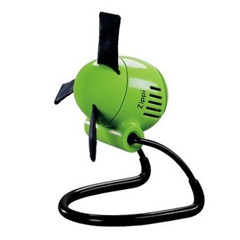
Meet Zippi: Suitable for propeller sounds of all kinds!
It’s been a long time since I’ve done a Thrift Store Sounds post, so let’s take a look at the nifty Vornado Zippi desktop fan!
It features soft cloth blades, a safety feature given the lack of a cage around the hub and its inevitable placement next to coffee mugs, iPads, and human fingers.
The motor’s not very powerful, and that’s really perfect for sound design. You can put your hand on the hub to slow it down. The soft blades let you stick all manner of wacky things in them without damaging the objects or the blades.
Today’s sound, then, is a short takes of sticking a ball-point pen into the fan blades. I think it’s great as a layering element for propeller sounds, be it a steampunk zeppelin or a toy/cartoon aircraft.
(If you want to hear more Thrift Store Sounds, be sure to check out recordings of a wicker basket and a shoe stretcher, or just use the Search too!)
[soundcloud url=”http://soundcloud.com/noisejockey/zippi” params=”show_comments=true&auto_play=false&color=dd0000″ width=”100%” height=”81″]
[OktavaMod MK-012 with cardioid cap, inside Rycote Baby Ball Gag windshield, into Sound Devices 702 recorder]
Tags: blade, digital audio, fan, found object, props, sound design, sound effects | 1 Comment »
Posted: July 22nd, 2010 | Author: Nathan | Filed under: field recording, found sound objects

Mmm, so many tasty, carcinogenic choices.
Like over 100 other field recordists, I signed up for Tim Prebble’s crowdsourced special effects library of doors from around the world on his boutique effects label, Hiss and a Roar.
Unfortunately, due to extenuating circumstances, I had to bow out of the project, and a number of other side-projects. (Saying “no” is a powerful tool to help rein in your life from your own over-committal. Just do it early enough.)
However, one of the more interesting doors I did manage to record was the hinged front panel of an all-metal, 1970’s-era cigarette vending machine. This thing lives in my office, inherited from previous tenants. It’s too big to get rid of, and too odd and ironic to let go of, since none of us smoke. This object has been heard here before.
In honor of the awesome work everyone has done on this upcoming release, today’s sound is a fragment of my own aborted contribution, in the hopes that everyone will support Hiss and a Roar and pick up the collection when it’s released.
[soundcloud url=”http://soundcloud.com/noisejockey/cigmachinedoorslams” params=”show_comments=true&auto_play=false&color=dd0000″ width=”100%” height=”81″ ]
[Sennheiser MKH 50/30 mid-side stereo pair with into Sound Devices 702 recorder]
Tags: creak, digital audio, door, field recording, found object, machine, metal, sound design, sound effects | 8 Comments »
Posted: July 14th, 2010 | Author: Nathan | Filed under: field recording, found sound objects, sound design
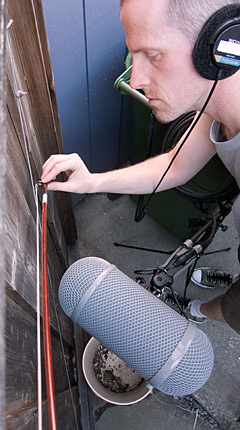
Noise Jockey: Taking the "E" out of "e-bow."
Almost exactly one year ago, I played a steel cable on a gate with an eBow , recorded with contact microphones. I decided to give it a go with a regular bow when I realized that this gate was basically a one-stringed guitar.
, recorded with contact microphones. I decided to give it a go with a regular bow when I realized that this gate was basically a one-stringed guitar.
Think about it: Wound metal string under tension, wooden resonator. That’s all a guitar really is. What a wooden gate lacks is thickness, like a guitar, but at more than a meter in width and height, that’s a broad-enough surface to send air molecules running for cover.
I had to rosin the hell out of the bow to make it tacky enough to grip this oversized “string.” I found that also spreading rosin on the wrapped steel cable was helpful. I tuned the cable, as much as one can, by adjusting a turnbuckle.
I recorded in mid-side stereo. Today’s sample features is comprised of one mono track totally dry, one mono track run through Michael Norris’ Spectral Blurring effect, one mono track pitch-shifted down by 1.5 octaves, and the one stereo track pitch-shifted down by three octaves. Recording at 192Hz helps for such tomfoolery.
I apologize to my neighbhors for the unholy racket that I’m sure they thought was a demonic violin 101 class.
[soundcloud url=”http://soundcloud.com/noisejockey/satans-violin-lesson” params=”show_comments=true&auto_play=false&color=dd0000″ width=”100%” height=”81″ ][Sennheiser MKH 50 and MKH 30 recorded as mid-side stereo into Sound Devices 702 recorder]
Tags: digital audio, drone, experimental, field recording, found object, industrial, metal, mid side, sennheiser, sound design, sound effects, violin bow | 5 Comments »
Posted: July 3rd, 2010 | Author: Nathan | Filed under: field recording, gear, nature recording
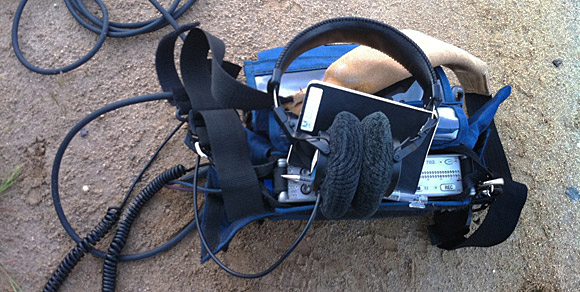
Neither dirt, nor fog, nor clouds of mosquitos keeps a field recordist from his crack-of-dawn tasks!
I’m finally unpacked and rested from the inspiring (and exhausting) 26th Annual Nature Sounds Society Field Workshop in California’s Sierra Nevada. Since my last post was a compilation of high-level personal experiences, I thought that I’d report back about what worked, or didn’t work, in the field on the technology side of things…as well as share a recording from our first early-morning field session.
- Outdoor Gear. My REI trail stool was instrumental in keeping my body still (I can be a fidgety so-and-so), the importance of which can’t be understated when your preamp gain is at 80% of maximum and you can hear birds’ wing flaps 20 meters away. [Hint: For nature recording, more layers of softer materials – like fleece, soft-handed polyester, and wool - are the best for staying warm and silent. Consider gaffer-taping your metal zippers, too!]
- Microphones. My primary MKH 50/30 rig performed brilliantly, with a strong signal-to-noise ratio even in the quietest moments. I also got a chance to try out a rather large parabolic microphone…more on that in a later post. [Hint: If you want a mic for nature recording, you need to be looking in the <-16dBA self-noise range, the lower the better.]
- Recorders. The ol’ 702 worked its usual wonders. I monitored as mid-side in the field, only converting to left/right once I returned. A +8dB side signal using Tom Erbe’s +Matrix plug-in made for a wide, enveloping sense of space without losing center imaging. Â [Hint: Batteries drain faster when cold. Store spares inside your jacket, or in your sleeping bag with you overnight!]
The gear list across everyone was pretty insane: many Olympus LS10 recorders, several Sound Devices 744T’s, a Sony PCM-D50, and mics from DPA, Neumann, Røde, Sennheiser, and Telinga. Recording techniques varied from mono to mid-side stereo, XY stereo, ORTF, Jecklin discs, and even two binaural dummy-head rigs (see this site for a good explanation of all this alphabet soup). An outdoor mic directionality seminar helped to illustrate what each is good for, which was a rare opportunity and extremely educational.
Yeah, yeah, whatever. But what did it sound like?
Today’s sound was recorded around 5:45am on a day with a slight breeze and scads of ground fog. The location was Sierra Valley, north of state route 49 in the Sierra Nevada. This recording includes at least swallows (cave or barn, I’m unsure), American bitterns, red-winged blackbirds, white-faced ibises, yellow-faced blackbirds, and a bullfrog, and certainly more that I can’t identify.
Get those headphones on and close your eyes…
[soundcloud url=”http://soundcloud.com/noisejockey/amb-bird-dawnchorus-sierravalley-01″ params=”show_comments=true&auto_play=false&color=dd0000″ width=”100%” height=”81″ ]
[Sennheiser MKH 50 and MKH 30 recorded as mid-side pair into Sound Devices 702 recorder]
Tags: audio equipment, birds, birdsong, camping, digital audio, field recording, microphone, nature, nature recording, Sierra Nevada, sound design, sound effects | 5 Comments »
Posted: June 19th, 2010 | Author: Nathan | Filed under: found sound objects, sound design
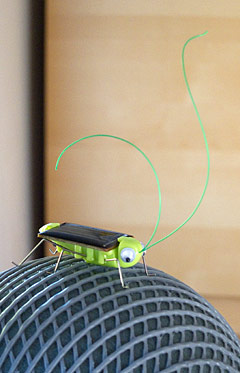
Sunshine on his shoulder makes him jumpy...
No sound designer can resist sound-making objects, so I did some recent damage at ThinkGeek for some small, inexpensive musical items…but then I noticed the robots.
Sadly, Â buying a spendy mechanical robot arm just to record servo sounds seemed like a horrible investment. I learned this lesson last year. ;-)
However, I did get a tiny solar-powered grasshopper kit. An offset actuator in its abdomen makes the whole thing vibrate on tiny wire legs when it’s solar-cell carapace is hit with sunlight or a strong halogen source.
Of course, that would sound tiny and delicate. Which is OK. But how to make that sound bigger? Well, you put it on something that will resonate: Something with air around it that will conduct vibrations easily. (I’ve had loud, racous luck with this before.)
Being a hot, sunny Sunday, I chose the top of my closed Weber grill. I tested the sound with contact mics, but the steel was too thick. Truly, and unusually, where my ears were – close to the top of the grill – was where the best sound was. I switched to a hypercardioid mic in a windscreen, and captured today’s sound.
To accentuate the lovely low-mid resonant tones, I applied a huge -24dB cut at 5.5kHz , where the metallic feet where vibrating against the grill (I still wanted a tiny hint of chatter  in there), tand a +9dB boost at 180Hz. Could make for a nice layer with some other design elements.
[soundcloud url=”http://soundcloud.com/noisejockey/hyperhopper” params=”show_comments=true&auto_play=false&color=dd0000″ width=”100%” height=”81″ ]
[Sennheiser MKH 50 into Sound Devices 702 recorder]
Tags: digital audio, drone, field recording, grasshopper, metal, robot, solar power, sound design, sound effects, vibration | 2 Comments »
Posted: June 14th, 2010 | Author: Nathan | Filed under: field recording, nature recording, sound design
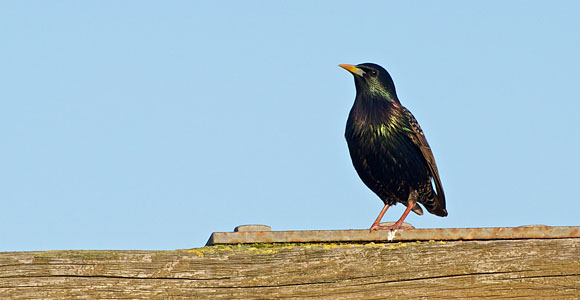
European Starling, hero mutterer and goer-on-forever.
[Photo by donjd2 (CC)]
The European Starling is a common bird that yammers like a manic street preacher. They have a really varied voice, quite expressive for standard birdsong.
I recorded one in my backyard and found that the frequency content really held up well under creative processing (unlike the raspy, high-mid-peaked calls of crows). Today’s sample is a continuous utterance from a starling that’s been pitched down 800 cents and run through the GRM Tools PitchAccum filter, which I just adore for thickening sounds in unusual ways.
For me, it’s evocative of an exotic or alien ecosystem, especially with those other weird R2-D2-like tones in the background…but, again, the vast majority of those tones are being made by a single Starling.
[soundcloud url=”http://soundcloud.com/noisejockey/mutant-starling” params=”show_comments=true&auto_play=false&color=dd0000″ width=”100%” height=”81″ ]
[Sennheiser MKH 50 into Sound Devices 702 recorder]
Tags: audio equipment, birds, birdsong, digital audio, european starling, field recording, sound design, sound effects | No Comments »
Posted: June 3rd, 2010 | Author: Nathan | Filed under: field recording, nature recording

Recording crows...it's murder, I tell ya.
Thanks to SocialSoundDesign.com, I’ve discovered the joys of iZotope RX, an amazing noise reduction tool that has made real one of my hopes: To capture reasonably clean sounds in my own back yard. I live pretty close to a major highway, so getting usable recordings has been impossible up until recently.
A neighbor’s willow tree harbors a very chatty and schizophrenic-sounding European Starling. While recording some of its yammering, a crow flew in, circled over me three or four times not more than 20 feet overhead, and then left, as if to warn me that I was too close to the community tree in Birdsville. I tracked him with my mic as he flew. Well, after that, I packed it in. It wasn’t going to get better than that.
The sounds of the background are still there, of course, but much less prominently than they were. The crow was close enough and I tracked accurately enough that while there’s a volume dropoff, there’s not a lot of apparent Dopplering. The caws are fairly shrill, so don’t turn this up too loud. (Note: From a sound design standpoint, pitch shifting crow vocalizations down doesn’t sound that interesting. They sound like asthmatic dogs coughing up a cat’s hairball, and not in a good way.)
[soundcloud url=”http://soundcloud.com/noisejockey/crows” params=”show_comments=true&auto_play=false&color=dd0000″ width=”100%” height=”81″ ]
[Sennheiser MKH 50/30 mid-side stereo pair with into Sound Devices 702 recorder]
Tags: audio equipment, birds, birdsong, digital audio, field recording, noise reduction, sound design, sound effects | 9 Comments »
Posted: May 20th, 2010 | Author: Nathan | Filed under: found sound objects, gear
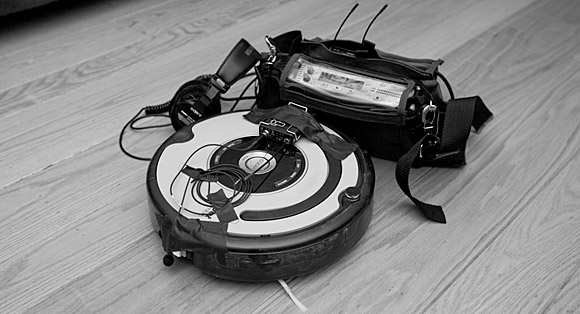
To paraphrase Ned Flanders, "That set my beatbox all the way up to Roomba!"
Lavalier microphones (“lavs”) are used with wireless transmitters and receivers all the time in the world of film and video production because, well, actors move. Sometimes it’s the best way to mic someone if you can’t keep up with their movement or a boom can’t get close enough, as with a wide shot. They’re not usually the first choice for miking talent, but they’re a common one and a good tool for certain conditions.
Wireless lavs are also handy in sound design for the same reason: Some things move. When they move, you need to pan your mic with it, or accept off-axis sound falloff, or be trying to get a Doppler effect. If you want your mic point-of-view to stay on something moving, and a cable’s going to get in the way, then a wireless mic system is just the ticket.
But, as with everything, there are some caveats.
Read the rest of this entry »
Tags: countryman, DPA, lav, lavalier, Lectrosonics, receiver, roomba, sound design, sound effects, transmitter, vacuum, wireless audio | 4 Comments »









